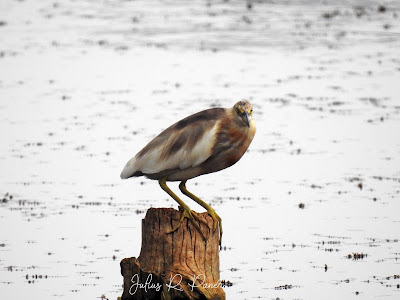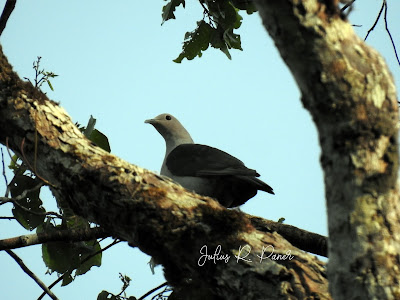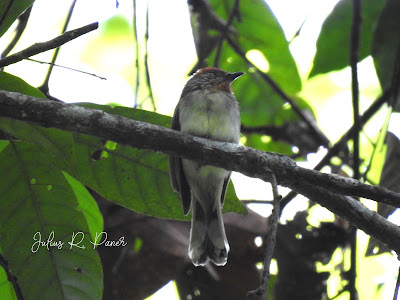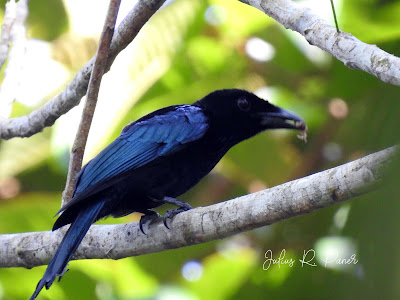Bislig City is the Mecca of Mindanao Birding, as a good friend Alden would put it. Indeed, it is true. I affirmed it just recently when my group The Big Year Davao was invited by Atty. Conrad Cejoco, the good Board Member of Surigao del Sur whom I met sometime 2009. This provincial legislator is on to a serious fight for conservation particularly in the City of Bislig where environmental challenges are obvious. I wish other political leaders learn from him.
The purpose of Atty. Conrad’s invitation is for us to document birds and
other wildlife in Bislig which would soon be utilized as baseline for a more
detailed conservation plans of the city in particular and the province of
Surigao del Sur in general. Thankfully, 3 of the main pillars of The Big Year
Davao were there to join the activity in bird expert Pete Simpson, wildlife
photographer Alden Fernandez and conservationist Joshua Donato. This team is
somehow perfect to quench the outputs that Sir Conrad wanted from us.
The first day of travel had me joining Alden in his car while Joshua joined Pete in his SUV. We arrived in Bislig by 10:30 AM with Sir Conrad meeting us at the Bislig Government Center. After a productive conversation and pre-arranged lunch in Tinuy-an Falls, we started scanning for birds in a site just above Tinuy-an Waterfalls. Immediately we were greeted with good sights of Yellowish Bulbul, Hair-crested Drongo, Buzzing Flowerpecker, Philippine Trogon, Black-naped Monarch and the precious Short-crested Monarch.
The next few hours on day 1 were spent trekking to sitio Sote. I remembered the place very well as it was venue of our immersion program with Mountaineering Federation of Southern Mindanao in year 2009. Nothing has changed much except that the forest cover has decreased dramatically. On the way to our transient hut we crossed a calm but deep river system that connects to Tinuy-an Falls. Prior to crossing the river through a canoe a lone Southern Silvery Kingfisher showed up but very busy catching Damselflies for afternoon snacks. Above the river is flock of mixed birds such as Philippine Leaf Bird, Whiskered Tree Swift, Mindanao Hornbill, Philippine Green Pigeon, Pink-bellied Imperial Pigeon and Green Imperial Pigeon. Another 5 minutes of trekking from the river brought us to a hut owned by a tribal leader in Sote where we stayed overnight. The perimeter of the hut is a good refuge of Blue-crowned Racket-Tail, Coleto, White-bellied Woodpecker, Mindanao Hornbill, Black-naped Oriole, Philippine Coucal and White-eared Brown Dove, among others. After a good dinner Pete spearheaded an inventory of night birds in the adjacent forest. The evening cast of owls were almost complete, but the presence of a Mindanao Tarsier stole the show.
Day 2 was a lot bloodier. The trekking to a secondary growth dipterocarp forest was humid with fewer birds. Highlight was an appearance of Black-headed Tailorbird, Yellow-breasted Fruit Dove, Striated Wren-Babbler, White-eared Brown Dove, Philippine Pitta, Black-faced Coucal, Pink-bellied Imperial Pigeon, Mindanao Hornbill and Writhed Hornbill. At around 10:30 in the morning we headed back to the bunkhouse and left for lunch at Mangagoy where Atty. Conrad met us. We completed the second day with a quick visit in Lake 77 and Bislig Airport to see Whistling Ducks, Philippine Ducks, Purple Heron, Black-naped Monarch and few Whiskered Terns in summer plumage. The airport runway served as viewing site for Philippine Night Jar, Watercock, Paddyfield Pipit, Barred Rail and Clamorous Reed Warbler. We concluded the day with another sumptuous seafoods dinner at Sir Conrad’s house and left for River View Inn after some productive conversation.
On to the 3rd day, a long drive from River View Inn to PICOP’s Road 4 which according to Pete one of the best birding sites in Surigao. At the old cemetery we started the day’s session by recording special birds such as Green Imperial Pigeon, this time with a distant but good background for us to nail some good shots. Handsome Sunbird and Metallic-winged Sunbird are common in the place, too, along with Yellow-breasted Fruit Dove, Philippine Green Pigeon, Asian Koel and Black-faced Coucal. Going north of the road gave us distant view of Mindanao Hornbill, Writhed Hornbill and Rufous Hornbill. We also heard constant calls from Azure-breasted Pitta, Little Slaty Flycatcher and Mindanao Blue Fantail. After close to an hour of staying in Road 4 we finally saw the Celestial Monarch, not being able to perch for a photo session with us but the way it encircled above us was terrible. Bucket. That was good for a suspension of birding and got something for a good breakfast of egg and luncheon meat.
It was getting hot after our breakfast and what better way to cool down was to stay inside a forest trail. The most notable observation was a call from an immature Mindanao Wattled Broadbill which Pete refused to confirm until seen directly. Unfortunately the young bird did not show up. We recognize bird activities inside the forest with good sightings of Rufous Paradise Flycatcher, Rusty-crowned Babbler, Mindanao Pygmy Babbler, Yellow-wattled Bulbul, Yellowish Bulbul, Mindanao Blue Fantail and Rufous-tailed Jungle Flycatcher. We left the forest back to the car park and took an equally excellent lunch of chicken-pork adobo and went for another round of bird check in the cemetery to be reunited with Philippine Trogon, Hair-crested Drongo and an illegally-cut Red Lawaan Tree.
Pete wasn’t convinced to proceed to Road 42 due to a very limited time. We had to drive back to River View Inn to prepare talking points and presentation for another set of meeting with Sir Conrad, the City Administrator (in behalf of the Mayor), the City Tourism Officer and the Manager of Tinuy-an Waterfalls.
We were supposed to leave early for Davao on the 4th day but I insisted to go back to Tinuy-an for further birding, hoping that this time we would spot good angle of beautiful birds there. An early morning trek to a dilapidate resort in the upstream part of Tinuy-an had us seeing the Black-chinned Fruit Dove, Brown Tit-Babblers, Rufous-fronted Tailorbird, Olive-backed Flowerpecker and Southern Silvery Kingfisher, not to mention the Philippine Honey Buzzard being harassed by a Hair-crested Drongo. And just as we were about to take a final groufie opposite the Tinuy-an Falls arc we were treated with a good view of Yellow-breasted Fruit Dove.
To sum it up, this trip is totally different from the usual birding that our team has undertaken in the past. We were there not just to document birds and other wildlife, but at the same time share inputs about doable conservation mechanisms to save the remaining forests of Bislig. In unison we agreed that ecotourism is a viable strategy towards conservation, and that the Indigenous Peoples (IPs) should take the prime step in order to fast track projects and activities. The presence of Paper Industry Corporation of the Philippines (PICOP) in Bislig long time ago had taken a toll to its rich biodiversity from the mid-elevation forests down to the coastal sides where the seawater turned into dark brown color.
Lastly, Pete’s report saw 113 birds recorded in our 3 and a half day-tour, 66 of which are endemic in the country. This cumulates only five sites namely: Tinuy-an Falls/Resort, Sitio Sote, Lake 77, Bislig Airport and Road 4 Cemetery. Again, if all of us are bent on keeping all these birds stay in Bislig the best step is to protect the remaining forest in whatever means humanly possible. And that includes, among other things, involving the IPs in conservation, otherwise, they will keep cutting trees in all these sites.
x


































